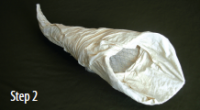Articles & Step By Step Tutorials
Learn new design styles and discover new techniques with these articles from Floral Focus magazines, and step by step tutorials.
A Passion for Period - Greek
GREEK 600 - 146 BC & ROMAN 28 - 325 AD
by Liz Chapman
This period, like many periods that we study for floral art, covers a long time and from a floral perspective, many generalisations are made.
We can only surmise how flowers may have been used by studying ancient manuscripts, paintings, sculpture and archaeological findings.
Both civilizations were very similar in that life was dominated by religious rituals, lavish banquets, civic ceremonies and sport. There is little evidence of cut flowers being used in vases, although research shows that leafy branches were used in tall pots to decorate courtyards and for festive celebrations.
Wreaths, chaplets and garlands were popular ways of using plant material, particularly for significant occasions.
They were worn at weddings, exchanged by lovers or hung on doors to celebrate a birth or other important events.
The wreath was a symbol of eternity, allegiance and dedication. It was a great honour to be given a wreath of laurel or oak and these were usually awarded to honour poets, athletes, civic leaders, victorious soldiers or other heroes. Garland, chaplet and wreath makers were very proficient and were undoubtedly the equivalent of today's florists.
During lavish festivals it was common to have flowers and petals strewn on the streets, on floors or over banquet tables.
The Thyrsus, portrayed in Greek paintings and sculptures, was a tall slim staff carried at the festival of Bacchus to symbolise enjoyment and fertility. It was made from a giant fennel stem, entwined and covered with ivy, a pine cone on top and usually decorated with leaves, berries, grapes or ribbons.


The Cornucopia, a large horn shaped container (based on the shape of a goat's horn) was a symbol of abundance and plenty attributed to both the Greeks and Romans. It was used to gather fruit and flowers.
Make your own Cornucopia
To make a replica Cornucopia suitable for use in a Green or Roman Period design you will need:
* Galvanised wire netting, approximately 750 millimeters by 500 millimeters.
* A piece of cotton fabric - calico or an old sheet is best. Do not use a polyester based fabric.
* PVA glue, Paint, Rubber gloves and pegs.
Step One
Shape the netting into a horn shape.
Secure the edges by overlapping ends of
netting and pressing firmly.
Step Two
Wet the fabric and wring out as much water as possible. Completely immerse the fabric in full strength PVA glue. Wrap wet glued fabric around the wire netting shape. You may need to peg the ends but remove pegs before completely dry. Leave to dry thoroughly.
Plaster of Paris may be used as an alternative to PVA glue.


Step Three
When fabric is completely dry, paint to the colour of your choice - a natural colour is most suitable for this era.
The cornucopia featured here has been painted with a stone effect aerosol spray. Complete the finished cornucopia with plant material appropriate for the era e.g. grape fruit or foliage, medlar, apples, olives, figs, walnuts, rosemary, thyme, oak or laurel foliage.

Categories
- Step By Step Tutorials
- Colour Tutorials
- Techniques Tutorials
- Innovative Design Tutorials
- Styles Tutorials







